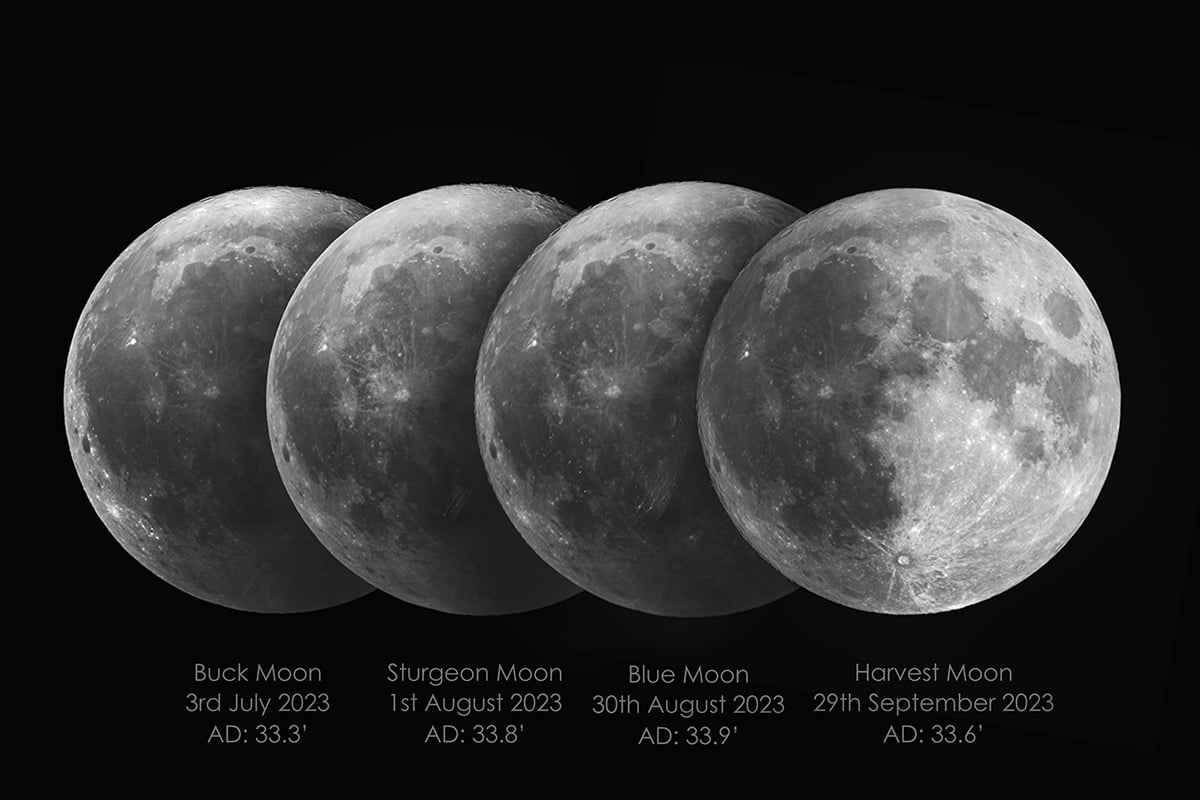
The supermoon is coming up on the 17thTh September. A great opportunity to photograph the larger moon.
When the moon’s closest approach to Earth coincides with a full moon, it is called a supermoon. As a result, the moon appears to be slightly closer and brighter. However, it is difficult to see the difference with the naked eye. Supermoons appear nearly 14% larger and about 30% brighter than micromoons when the Moon is farthest from Earth. Although the difference in size may not be visible to the naked eye, you will definitely see the change in brightness.


Definition of Supermoon
This is how NASA defines a supermoon:
A “supermoon” occurs when a full moon coincides with the moon’s closest approach to Earth in its elliptical orbit, at a point known as perigee. During each 27-day orbit around Earth, the Moon reaches its perigee, about 226,000 miles (363,300 km) from Earth, and its furthest point, or apogee, about 251,000 miles (405,500 km) from Earth. Because the Moon’s orbit fluctuates and varies depending on where the Sun and Earth are in their orbits, the exact distance of these closest and farthest points varies, and some supermoons are closer or further away than others.
NASA
You can watch this animation from NASA/JPL to better understand how supermoons appear in the sky.
What is a Supermoon?
However, the term supermoon is not an official astronomical term. The term as it is currently used was first used in 1979 by astrologer Richard Nolle. Additionally, when a full or new moon is within 90% of its closest point to Earth, it qualifies as a supermoon according to Nolle’s criteria. On the other hand, supermoon calculations vary between websites.


Upcoming supermoons
This week we will see a supermoon in the night sky. However, we will get the same in October and November 2024. Here are the 3 upcoming supermoons this year and their distance from Earth:
- September 17Th: 222,131 miles (357,485 kilometers)
- October 17Th: 222,055 miles (357,363 kilometers)
- November 15Th: 224,853 miles (361,866 kilometers)
The October supermoon will be the closest to Earth, thus the biggest full moon of the year.


How to photograph a supermoon
Photographing supermoons is identical to photographing other full moons. You’ll need a DSLR or mirrorless camera along with a telephoto lens or telescope to capture it. The focal length of your lens may vary, but in general, if it’s longer than 200mm, you’ll get some detail of the lunar surface. Use the maximum focal length you have. The longer the better. With these settings, you can achieve a beautiful image.
Aperture: Use the sharpest aperture of your lens. Normally this is 1 or 2 stops lower than your lens’s maximum aperture. Try to keep the aperture between f/8 and f/11.
Shutter speed: Like any other object in the sky, the Moon moves. Keeping the shutter speed faster will make the image sharper. As a general rule, your shutter speed should be twice your focal length. For example, if you are using a 500mm lens, the shutter speed should be 1/1000s. However, if you are using a tripod, you can reduce it to 1/800s or 1/640s.
ISO: There are no set rules for ISO. Since the moon will be very bright, you won’t need a high ISO. After setting the desired aperture and shutter speed, adjust the ISO accordingly. Don’t forget to check the histogram and pay attention to the highlight clipping.
Tips to get a better picture
Here are some more tips for a better and sharper image:
- Use a tripod. This will allow you to take sharper pictures. You can also lower the shutter speed and keep the ISO lower.
- Take multiple pictures of the moon. Although there are no general numbers, shooting 100 or 200 images should be sufficient. Stack these images to get a noise-free image along with additional details of the moon.
- Use an external intervalometer or an internal intervalometer (if your camera has one). This will prevent shocks that could be caused by shaking the camera.
- Use manual focus to achieve the best focus. Autofocus may or may not work.


If you happen to have an older picture of the moon, place it next to the picture of this supermoon and see the difference in their size. Remember that the equipment must be similar (same focal length and sensor size) to achieve a true comparison.
I hope you manage to capture the mighty supermoon. Clear sky.
#Dont #weeks #Supermoon #top #tips #successful #photo #shoot
